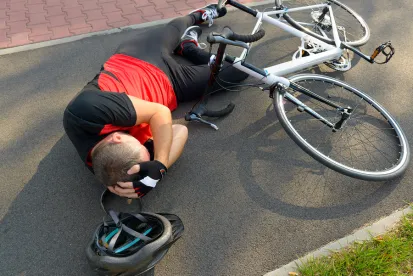In the United States, over 130,000 people are injured in bicycle crashes every year, according to the CDC. The costs of the injuries and deaths from these crashes typically exceed a staggering $23 billion yearly.
An easy and effective way to reduce the number of people injured in bicycle crashes is to make sure that every cyclist wears a helmet.
Why Wearing a Bike Helmet Matters
A meta-analysis published in 2018 found that wearing a helmet at the time of a bike accident has the following positive impacts:
-
Reduced head injury by 48%
-
Reduced severe head injury by 60%
-
Reduced traumatic brain injury by 53%
-
Reduced face injury by 23%
-
Reduced the number seriously injured or killed by 34%
The effectiveness of bicycle helmets is crucial because many children ride bikes—young people between the ages of 10 and 24 make up a third of all bicycle-related injuries in emergency departments across America.
A study published in 2020 found that patients who wore helmets during bicycle-related accidents were 95% less likely to be diagnosed with a head injury. These results show that wearing a helmet is imperative, particularly for children under 18.
Common injuries sustained in bike accidents and their long-term impacts
Injuries sustained in a bicycle crash vary depending upon the nature of the accident, but some common injuries include:
-
Road rash
-
Concussions
-
Traumatic brain injury
-
Facial or dental damage
-
Broken bones
-
Sprains or strains to wrists and ligaments
Concussions and traumatic brain injury (TBI) are some of the most severe consequences of bicycle accidents. For concussions, the short-term effects can include:
-
Light and noise sensitivity
-
Headaches
-
Confusion
-
Vertigo or balance disruptions
-
Mental fatigue or difficulty concentrating
Depending upon the severity of the trauma, a TBI could have the following long-term effects:
-
Headaches and migraines
-
Memory loss
-
Seizures
-
Dizziness and balance problems
-
Fatigue
-
Paralysis
-
Reduced language skills
-
Mood swings
-
Visual changes
Head injuries have lasting consequences that could render an individual permanently disabled and unable to work, depending upon the severity of the damage.
Critical Safety Tips for Cyclists
Wearing a helmet is one of the best things cyclists can do to ensure their safety. But there are other steps you can take. Some additional safety precautions are:
-
Wearing fluorescent or retro-reflective clothing or materials
-
Equipping your bicycle with front and rear lighting
-
Wearing lighting on your person
-
Using protected bike lanes when possible
-
Using hand signals to indicate turns
According to the Pedestrian and Bicycle Info Center, 48% of bicycle accidents occur around dusk, primarily between 6 and 9 PM. Because accident rates are higher during these hours, we recommend that all cyclists wear reflective materials and equip their bikes with lights when riding at night.
New Jersey Bike Helmet Legislation
At this time, there are no federal helmet laws. Instead, the issue is decided at the state level, and in New Jersey, everyone under the age of 17 who rides a bicycle or is a bicycle passenger must wear a safety helmet.
The helmets worn by cyclists must meet the latest standards developed by the Consumer Product Safety Commission (CPSC) in 1999. Helmets should be fastened and fitted securely with strong chin straps to keep them in place during a crash. If you buy a new helmet, look for the label indicating that it complies with CPSC standards.
Children should make it a habit to wear helmets. If they don’t, their parents could pay the price. If a minor violates New Jersey helmet laws, their parent or legal guardian could be fined up to $26 for the first offense, and $100 for subsequent offenses, depending upon whether a lack of parental supervision contributed to the violation.



 />i
/>i

